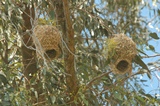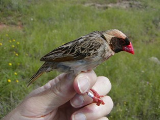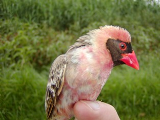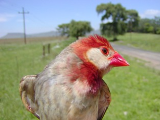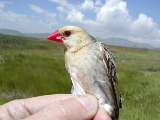Weaver news
| Walsh N, Dale J, McGraw KJ, Pointer MA, Mundy NI. 2012. Candidate genes for carotenoid coloration in vertebrates and their expression profiles in the carotenoid-containing plumage and bill of a wild bird. Proceedings of the Royal Society, B 279: 58-66 Abstract. Carotenoid-based coloration has attracted much attention in evolutionary biology owing to its role in honest, condition-dependent signalling. Knowledge of the genetic pathways that regulate carotenoid coloration is crucial for an understanding of any trade-offs involved. We identified genes with potential roles in carotenoid coloration in vertebrates via (i) carotenoid uptake (SR-BI, CD36), (ii) binding and deposition (StAR1, MLN64, StAR4, StAR5, APOD, PLIN, GSTA2), and (iii) breakdown (BCO2, BCMO1). We examined the expression of these candidate loci in carotenoid-coloured tissues and several control tissues of the red-billed quelea (Quelea quelea), a species that exhibits a male breeding plumage colour polymorphism and sexually dimorphic variation in bill colour. All of the candidate genes except StAR1 were expressed in both the plumage and bill of queleas, indicating a potential role in carotenoid coloration in the quelea. However, no differences in the relative expression of any of the genes were found among the quelea carotenoid phenotypes, suggesting that other genes control the polymorphic and sexually dimorphic variation in carotenoid coloration observed in this species. Our identification of a number of potential carotenoid genes in different functional categories provides a critical starting point for future work on carotenoid colour regulation in vertebrate taxa.
The Red-billed Quelea is a socially monogamous, granivorous passerine that is a major crop-pest in sub-Saharan Africa. It is highly variable in colouration within and between sexes. In the non-breeding season the sexes are alike, with a melanin-based dull brown plumage, and a carotenoid-based red bill, eye-rings and legs. The red colour of the bill and feathers is due to enzymatically derived keto-carotenoids. Breeding males moult into a bright plumage that varies in breast colour (red to buff) and in face colour (white to black) as shown in the photos above. This varying breeding plumage is thought to be under sexual selection for signalling individual identity among neighbouring territorial males. Red-breasted males have variable amounts of keto-carotenoids present while buff-breasted males have no carotenoids in the plumage. The mask colouration is due to different levels of eumelanin and also has a strong genetic basis. In breeding males, the redness of the bill correlates with overall body condition and with social dominance, thus serving as a badge of status. The authors found large differences in the concentration of four ketocarotenoids among feathers of red- and buff-breasted males, but the ketocarotenoids were present in similar ratios in male bills and plumage. Literature as featured in Weaver Watch news items |








